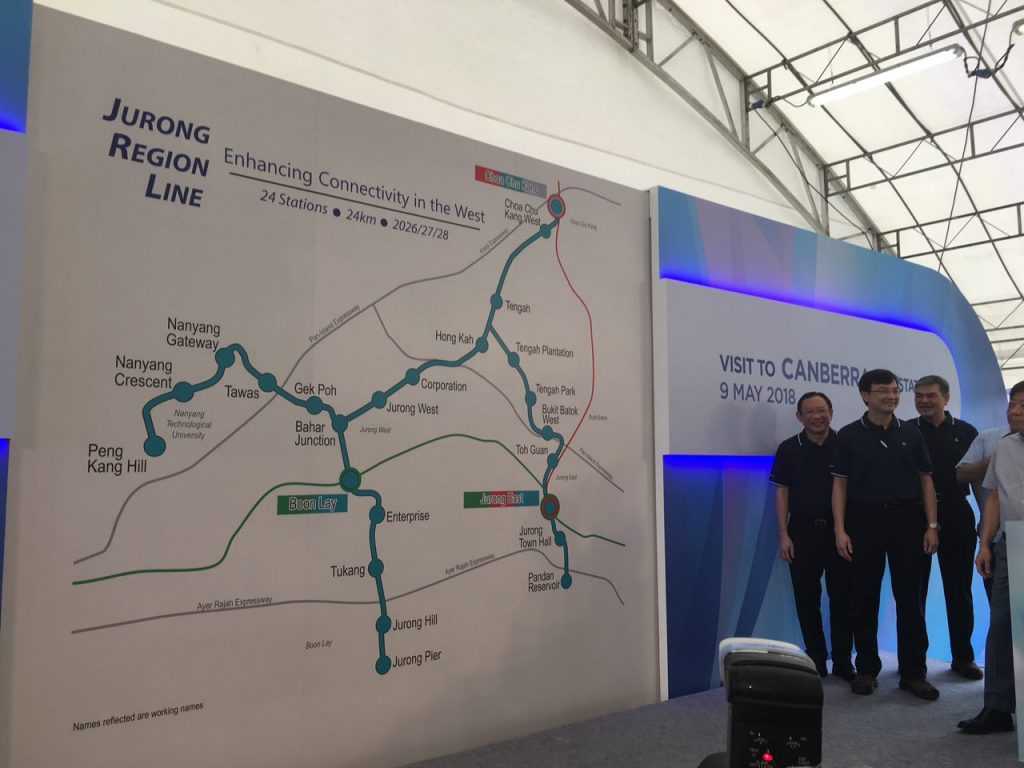The Jurong Region Line (JRL), Singapore’s seventh MRT line, will have 24 stations and open in three phases starting from 2026.
The future 24-kilometre elevated line will serve residents in Choa Chu Kang, Boon Lay and future developments in the Tengah area. It will also serve Nanyang Technological University, Jurong Industrial estate, Jurong Island and the future Jurong Gateway development.
The Jurong Region Line (JRL) will interchange with the North South Line at Choa Chu Kang and the East West Line at Boon Lay. At Jurong East, passengers can connect with both lines, along with the future Singapore–Kuala Lumpur High Speed Rail for connections to Malaysia. It also offers commuters alternative travel routes, redistributing and relieving train loading between Choa Chu Kang, Jurong East and Boon Lay stations.
The construction of the JRL is in tandem with the Government’s vision for Jurong, as part of building up Jurong Lake District into the largest commercial hub outside the Central Business District and support the development of the Jurong Innovation District. In the future, Jurong will be a waterfront business hub nestled in greenery, served by good public transport connections, as well as amenities to support active mobility
Train Stations
The station names reflected here are working names. The final station names are to be finalised.
Phase 1 – Jurong Region Line (West) – 2026
- JS1NS4BP1 Choa Chu Kang
- JS2 Choa Chu Kang West
- JS3 Tengah
- JS4 Hong Kah
- JS5 Corporation
- JS6 Jurong West
- JS7 Bahar Junction
- JS8EW27 Boon Lay
- JW1 Gek Poh
- JW2 Tawas
Phase 2 – Jurong Region Line (East) – 2027
- JE1 Tengah Plantation
- JE2 Tengah Park
- JE3 Bukit Batok West
- JE4 Toh Guan
- JE5EW24NS1 Jurong East
- JE6 Jurong Town Hall
- JE7 Pandan Reservoir
Phase 3 – Jurong Region Line (West) Extension – 2028
- JS9 Enterprise
- JS10 Tukang
- JS11 Jurong Hill
- JS12 Jurong Pier
- JW3 Nanyang Gateway
- JW4 Nanyang Crescent
- JW5 Peng Kang Hill


According to the locations of the stations released by LTA, the distance between some stations are very close which starts to make me question the practicality of introducing JRL as an MRT line.
For example, the distance between Bahar Junction and Gek Poh is too close. The distance between these two stations is, in fact, less than the distance between two bus stops. The three stations located in NTU (from Nanyang Gateway to Peng Kang Hill) is also very close to each other.
Which we are considering the distances between the stations and other potential problems (e.g. width of roads and space availability), is it better than JRL is an LRT line? Even if JRL is an LRT line, could there be many potential problems (like those in BPLRT) which will ultimately compromise reliability? Since I notice the similarity between JRL and BPLRT that the rail-lines are ‘shoe-horned’ into developed estates.
Regards,
Jonathan Leong CK